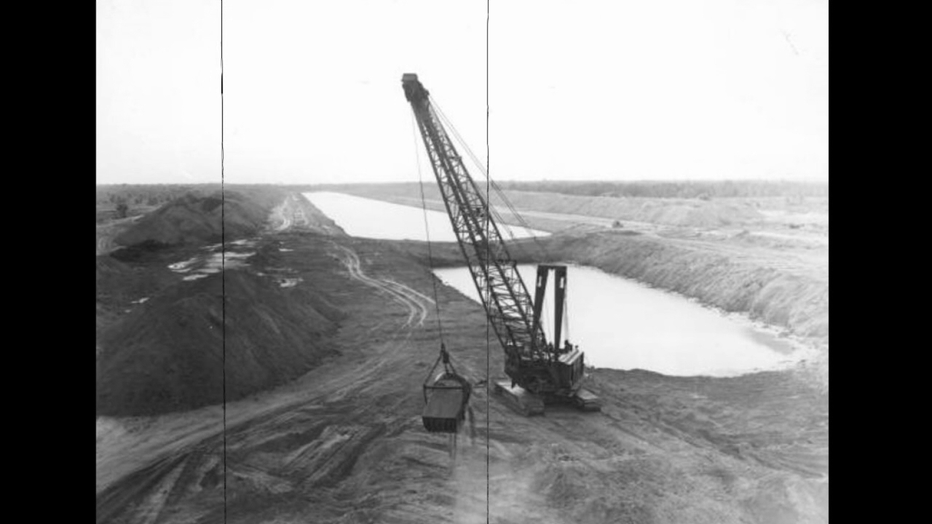Florida's Boondoggle: FOX 13 investigates the Cross Florida Canal part 3 of 4

Florida's Boondoggle Part 3
FOX 13 chief investigator Craig Patrick gives us a look at the damage done when the federal government tried to dig through Florida, and the ongoing push to fix it.
TAMPA - The federal government wasted millions of dollars and seriously damaged Florida’s environment by trying to dig a canal through Central Florida. Engineers said the project was impractical long before construction started in 1935, was canceled in 1936, and resumed in the 1960s.
"It was going to be… The Mississippi River across Florida. Of course, it was a crazy idea, and it never happened," said Florida Defenders of the Environment President Steve Robitaille.
"Most people understood we didn’t need a canal," said 'A Cruisin Down the River' Captain Erika Ritter. "It was an antiquated idea and nobody thought this would be funded and go forward."
And one very special river took the hardest hit.
"It’s very devastating to realize what was there and what was lost," Ritter said.
She grew up on the famous and winding Ocklawaha River, and she gives tours on what's left of it today.
FLORIDA'S BOONDOGGLE: PART 1 | PART 2 | PART 3 | PART 4
"It is a wild and scenic river. It was a narrow-canopied channel, and it was usually, most times of the year, very clear water."
The winding Ocklawaha River flowed freely north from the chain of lakes in Central Florida to Silver Springs and the St. John's River until the canal project came along.
"I would say it is unique in Florida for the kind of river that it is," Robitaille said. "If we could transport ourselves back to Florida in 1935, we would think it's Eden."
It was a tourist's paradise going back to the late 1800s.
"The reflections off the canopied foliage and the river turns it into a fairyland," said University of Florida History Professor Dr. Steven Noll.
Long before rockets and theme parks, the canopied Ocklawaha River was the crown jewel that drove Florida tourism, with testimonials from President Grant, Thomas Edison, and Mary Todd Lincoln.
"In the olden days when they had steamboats on this river," Robitaille explained. "They would come at night through these narrow wonderful channels, and they would light torches on the steamboats for the tourists, so you can see the eyes of alligators shining in the distance."

Author Harriet Beecher Stowe, who had turned her readers off the blight of slavery, later turned them onto the beauty of the Ocklawaha. The river was rolling with striped bass and sturgeon, and wildlife they had never seen before.
"And strange creatures in the river like manatees," said Noll. "They compared it to the Amazon, Nile, Congo even though they’d never been to those places. But it’s one of those wild and natural rivers that they see as going away."
And this is what they dammed up to build a reservoir to serve that ill-fated barge canal. It also cut off the natural path of migration for a lot of the fish.
"Well, sturgeon, for example. They were in the river at one time too, but they’re gone. We’ve lost the striped bass altogether," said Florida Defenders of the Environment Jim Gross. "The manatees find it very difficult to get up and down the river."
That's where the naturalists who opposed the barge canal enter the picture. Marjorie Harris Carr led the resistance. In 1969, she and a small group of scientists and activists formed a group called the Florida Defenders of the Environment.
"She literally runs this operation out of her kitchen…with mimeograph machines and volunteers," said Robitaille. "One of the most famous images of her is on a telephone and whoever was on the other end of the telephone was getting an earful!"
Carr and the Defenders produced an environmental study that revealed the barge canal's toll on the environment. They also sued, and convinced Reader's Digest to publish a piece called 'Rape on the Ocklawaha'.
"Reader’s Digest is the journal of middle America (at the time)," explained Noll. "They read this and say wow, this is crazy, what’s the purpose of this thing?"
The protests reached President Nixon. He issued an executive order to cancel the barge canal project in 1971.

"Nixon sees this as an opportunity," said Noll. "He thought these people who hate me—if I do some environmental stuff, they might like me."
While they canceled any further construction of the canal, they did not take down the dam. It still redirects much of the water from the river and divides Florida to this day.
A powerful State Senator named George Kirkpatrick lobbied his fellow lawmakers to keep the dam in place. He said the reservoir behind the dam has good bass fishing and helps the surrounding economy. It sparked a long-running battle between Marjorie Carr and George Kirkpatrick.
"On some level it’s a cultural divide," Noll added. "It’s bass boats versus kayaks is what it is."
State leaders turned land that had been set aside for the rest of the canal into a linear greenway and named it after Marjorie Carr. They kept the Dam on the Ocklawaha and named it after George Kirkpatrick. Both spent the final years fighting over the dam, and both died more than 20 years ago. But now this story is taking yet another turn as lawmakers take a closer look at the aging Rodman/Kirkpatrick Dam.
"The Rodman Dam is 55 years old, and it has a 50-year-old shelf life," said State Senator Jason Brodeur, a Republican who represents Orange and Seminole Counties. "And so any day now something could happen."
State lawmakers will eventually have to decide whether to replace or remove the dam in what will be the next and possibly final chapter of the Cross Florida Canal.
SIGN UP: Click here to sign up for the FOX 13 daily newsletter

